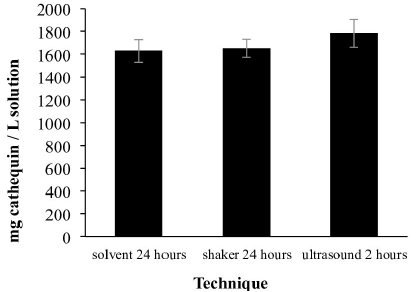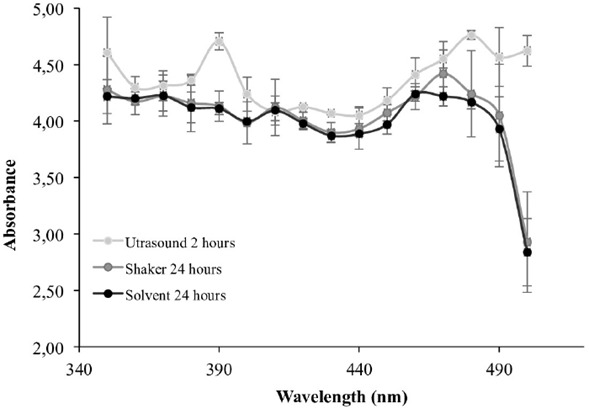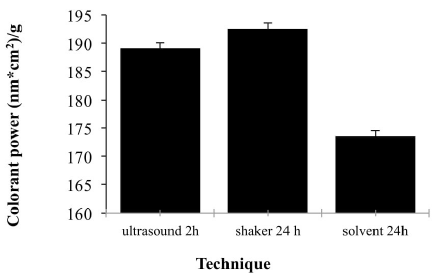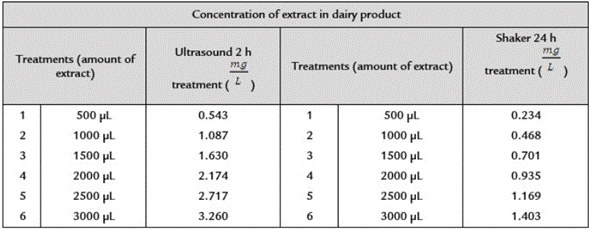INTRODUCTION
Food, cosmetic and textile industries are known to use a large number of additives of synthetic origin that generally contaminate water sources, and have been classified as toxic, allergenic and even carcinogenic (Elbanna, Mohamed, & Khider, 2017; Leulescu et al., 2018; Piccaglia et al., 1997). Artificial dyes are widely used in the food industry because they are water soluble and have the presence of sulfonic acid groups which makes them easy to use. Additionally, these are cheaper and resistant to thermal treatments, extreme pH, light, and other factors (Rodriguez-Amaya, 2014; Tikhomirova, Ramazanova, & Vladimir, 2018). Although, since 1939 Japanese scientists have found that some synthetic dyes frequently used in the food industry cause cancer, and nowadays several studies indicate the negative effects of this type of additives on human health (Elbanna et al., 2017; Tikhomirova et al., 2018). For these reasons, it is necessary to look for alternative solutions, such as obtaining additives of natural origin to replace the synthetic additives.
The best known colorant used in the food industry is tartrazine (yellow color), which has been associated with hormonal alterations that can cause cancer, male sterility and allergic reactions (Bhatt, Vyas, Singh, John, & Soni, 2018; Leulescu et al., 2018; Asero, 1993). On another hand, plants have many colorants, and carotenoids are one of them. More than 600 carotenoids have been isolated and characterized from natural sources (Rodriguez-Amaya, 2014). Moreover, it is well-known that some carotenoids have antioxidant activity, and their effectiveness against diseases has been attributed specifically to their ability to interact with free radicals (Astley, Hughes, Wright, Elliott, & Southon, 2004; Demmig-adams & Adams, 2002; Rodriguez-Concepcion et al., 2018). Additionally, carotenoids have colorant power, so they can be used instead of artificial colorants that are dangerous for human health (Elbanna et al., 2017; Pires et al., 2018; Tikhomirova et al., 2018)
Colombia is a place of diverse crops of interest, many of them useful for medicinal purposes. According to the Alexander Von Humboldt Institute, in Colombia there are 2404 medicinal species in use, of which 214 are exclusively from Colombia. Among these last ones, one of the most important is the Calendula officinalis flower, highly used in the cosmetic and pharmaceutical industry of Colombia, for example as anti-inflammatory, healing and mouth inflammations treatment (Bernal, Garcia, & Quevedo, 2011).
Another feature of Calendula officinalis is its antimicrobial effect on fungi and bacteria, which has been exploited in pharmacological applications (Bissa & Bohra 2011; Chakraborthy 2008; Efstratiou et al., 2012; Gazala et al., 2016; Vora, Srivastava, and Modi 2018).
Compounds present in flowers can be extracted by different methods, such as solute/solvent (Babaee et al., 2013; Chakraborthy, 2012; Claros, 2005), soxhlet-assisted extraction (Kasiram, Sakharkar, & Patil, 2000; Nicolaus et al., 2017; Roopashree, Dang, Shobha Rani, & Narendra, 2008), supercritical fluids (López-Padilla, Ruiz-Rodriguez, Reglero, & Fornari, 2017) and ultrasound-assisted extraction (Luengo, Condón-Abanto, Condón, Álvarez, & Raso, 2014; Vora, Srivastava, & Modi, 2018) among others. However, extraction of natural colorant from plants has always been a challenging issue. Therefore, there is a growing demand for newer methods of extraction.
In this investigation, several metabolites extraction techniques were evaluated with the purpose of comparing them regarding the quantity of carotenoids and flavo-noids extracted from the Calendula officinalis flowers. At the same time, the antibacterial behavior of the Calendula officinalis extracts was evaluated. Moreover, each extraction technique was studied to determine the influence of both the colorant power of carotenoids and antibacterial capacity of the flavonoids. As far as we know, all these techniques have not been evaluated together to compare the quantity of flavonoids and carotenoids that can be obtained from Calendula officinalis.
MATERIALS AND METHODS
Extraction techniques selected to be compared were: solute/solvent techniques with and without agitation (Elbanna et al., 2017), soxhlet - assisted extraction technique (Nicolaus et al., 2017), and ultrasound - assisted extraction technique (Luengo et al., 2014). Plant material: flowers used were collected from Santa Elena, town located in Medellín-Colombia at an altitude of 2200 meters above sea level, with an average temperature of 14.5 ° C and a relative humidity of 89%. Chemicals: ethanol (EtOH), beta-carotene, distilled water (DW), EMB Agar, Salmonella-Shigella Agar and Oxytetracycline 50 mg injectable solution. Instruments: Dehydrator (LEMTM), Blade Mill (IKA Werke® MF 10 basic), Absorbance Spectrophotometer (Thermo Scientific® - genesis 20), Ultrasound Bath (Elmasonic® S30H), Soxhlet (StarFish multi-experiment work station - radleys®), Rotary Evaporator (DLAB® RE100-pro), Biosafety Cabinet (ESCO® Class II).
1. Metabolites extraction
Drying and pulverization: Fresh Calendula officinalis flowers was disinfected with sprayed alcohol (70%). Flower petals were dried at 40 °C during 48 hours to reduce humidity and concentrate compounds. After that, petals were removed when the weight became constant. Finally, dried petals were pulverized in a blade mill at 3500 rpm until a particle size of 0.5 mm was reached.
Solvent extraction with agitation (shaker): Pulverized petals were immersed in ethanol in a proportion of 1:10, at 30 °C, in darkness. Samples were put under agitation in a shaker at 150 rpm. Times of extraction of 10, 20, 30 minutes and 1, 2, 12, 24 hours were evaluated. To each time evaluated triplicate samples were prepared. The same procedure was used for solvent extraction without agitation (percolation), in this case shaker was not use.
Ultrasound - assisted extraction: Triplicate samples were prepared for 10, 20, 30 minutes and 1, 2, 12, 24 hours of ultrasonic. Each group of triplicate samples was subjected to an ultrasonic bath at 30 °C operating at 37 kHz frequency, during the different times described above.
Soxhlet - assisted extraction: 25 g of dried petals were mixed with 250 mL of solvent. Then, solvent was submitted to 140 °C to arrive at its evaporation point. Triplicate samples were analyzed to 1 and 2 passages of solvent through the soxhlet extractor.
UV-visible spectrometric analysis of extracts: After each treatment above described, each sample was centrifuged and the liquid part was analyzed.
Carotenoids determination was carried out following the colorimetric method designed by Biswas et al. (2011), with some modifications. Carotenoid concentration was determined through curve pattern using β-carotene as the standard of the method. Sample (known amount) was mixed with a known amount of acetone. Spectrophotometer lecture was performed to 449 nm. The target measurements were made with a fill cuvette of acetone.
Flavonoids determination was carried out following the colorimetric method designed by Marinova et al. (2005), with some modifications 100 µL of the sample was mixed with 30 µl of NaNO2 5% (p/v), 30 µL of AlCl3 10 % (p/v), 200 µL of NaOH a 1M, and adjusted to 1000 µL of total volume with the addition of distillate water. Absorbance lecture was performed to 510 nm and the results were compared with curve pattern using catechin as standard.
2. Color measurement
Extract concentration: Solvent was eliminated by rotary evaporator working at 40 °C and 175 mbar. Theoric colorant power: For known maximum wavelength and maximum value, spectrophotometric measurement was made between 350 and 500 nm (Srivastava & Vankar, 2015). Later, colorant power was made using a colorimetric method and equation reported by Sancho & Navarro (1957).
Where: A is wavelength of maximum absorbance, V is volume used in the extraction, p weigth of sample, d: thickness of the cuvette used in the spectrophotometer, usually 1 cm. Finally, units of colorant power are:
Food trial: A commercial dairy product (yogurt without sugar or flavor and half-skim, 3% fat, 7% protein y 2% carbohydrates) was chose for this test. First, a stock solution was made using 50 mL of yogurt and a known amount of extract (500 µL). Later, extract was added to the yogurt at five levels (500 µL each level) keeping the other ingredients constant. We use commercial dairy product (mango and tangerine flavored yogurts) to compare with yogurt with analyzed dye.
Color measurement: Color measurement was made by CIELAB (L, a, b) color space through colorimeter RGB-1002 with the optic probe LT-Lutron where L value describes lightness (L=0 black, L*=100 white), a* describes color intensity (red>0, green<0), b* describes color intensity (b>0 yellow, b<0 blue).
Visual test: A simple visual test was made using a five level hedonic scale with untrained judges, where five is "I like so much", and one is "I don't like at all".
3. Antibacterial activity
Antibacterial activity of Calendula officinalis extracts was developed against Escherichia coli (ATCC 25922) and Salmonella typhimurium (ATCC 14028) by diffusion technique in well, based on the method developed by Bauer et al. (1966) 20 mL of culture medium (EMB agar for E. coli and Salmonella-Shigella agar for Salmonella typhimurium) was inoculated with microorganism at 1% (v / v) with a concentration of 108 CFU / mL and transferred to sterile petri dishes. In 9 mm wells sealed with agar, 20 µL of the samples were deposited. Oxytetracycline 50 mg/mL was used as a positive control, and 20 µL of alcohol and sterile water were added to each one as a targets. The plates were incubated at 37±2 °C for 24 hours, and the inhibition halo was measured without including the diameter of the well. Each sample was made in triplicate.
4. Statistical analysis:
Fisher's least significant difference (LSD) procedure was used for statistical analysis trough Statgraphics Centurion software (One-Way ANOVA). The differences between the variables were analyzed to determine the significance through the unidirectional variance analysis, differences were considered significant at p <0.05 (or at a level of α = 0.05).
RESULTS AND DISCUSSION
1. Extraction yield according to treatment
Figure 1 compares the amount of carotenoids obtained according to the extraction technique used. When performing the extraction using soxhlet technique, in which the solvent is subjected to an increase in temperature until its boiling point, the amount of extract obtained could not be quantified. Although conventional soxhlet extraction has been used for a long time since its discovery in 1987, the main disadvantages of this technique are the long extraction time and the consumption of large quantities of used solvents (Murugan & Parimelazhagan, 2014). Additionally, some organic compounds are thermosensitive, as is the case of carotenoids. Therefore, the soxhlet extraction method is also not suitable due to the possibility of thermal decomposition of the target compounds, since the extraction generally occurs at the boiling point of the solvent used during the extraction a long time (Bimakr et al., 2011).
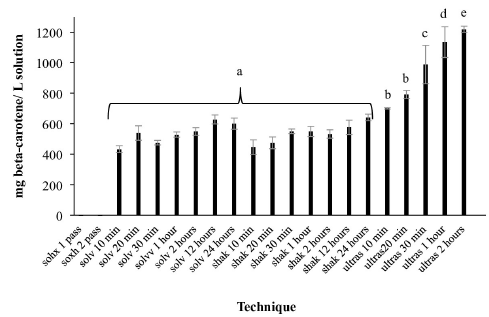
Figure 1 Quantity of carotenoids obtained according to the extraction technique. Comparison of all the techniques. Dates with the same letter have not significant statistical differences (soxh: soxhlet, solv: solvent, shak: shaker, ultras:ultrasound).
The extraction test in ethanol without agitation (percolation) shows a very similar amount of ethanolic extract, independent of minutes that ethanol was in contact with the samples (10 and 20 minutes, 1, 12 or 24 hours). Thus, time is not quantity obtained, does not require an increase in temperature and requires less time than others.
A conditioning parameter for obtaining more extract, at least for this technique. In the same way, the ethanol extraction test with shaker agitation (shaker samples) did not show differences in the extract quantity when comparing different contact times of the solvent with the flower. It was also not greater than the amount obtained without the agitation test. This last point indicates that agitation was not enough to increase the amount of extract obtained. Finally, analyzing the results obtained through the ultrasound technique it was observed that through this technique a greater amount of extract is obtained in comparison with the other techniques. It was also observed that as the ultrasound time increased, the amount of extracted metabolite increased too. Even comparing the best result of each technique (Figure 1), it was observed that with a 2-hour ultrasound treatment, a higher quantity of carotenoids was obtained than with the shaker technique for 24 hours. This behavior confirms that this technique is more efficient regarding extract. Similarly, in the flavonoids results (Figure 2) comparing the best result of each technique, it was observed that with a 2-hour ultrasound treatment a higher quantity of flavonoids was obtained than the solvent or shaker techniques performed for 24 hours. Some authors have reported that through ultrasound technique cell walls break more easily, releasing the extracts of interest. This is the case of Luengo et al. (2014), who reported that the ultrasound technique was the best in the extraction of carotenoids from tomato waste. They described that the mechanical effects of ultrasound could facilitate the release of the desired compounds from their matrices by breaking cell tissues and by providing greater solvent penetration into cellular materials. The effects of high-power ultrasound on the improvement of extraction are attributed to acoustic cavitation consisting in the formation, growth and collapse of micro-bubbles within a liquid subjected to high-frequency sound waves (⩾20 kHz).
2. Theoric colorant power:Figure 3 shows the results of the absorption spectrum in the best extraction treatments (ultrasound 2 hours, shaker 24 hours and solvent 24 hours). With this assay we want to see absorption bands related with some types of carotenoids. In general, treatments had similar behavior with maximum spectrum value between 450 and 500 nm, this results are agreeing with previous investigations with carotenoids, where reported that β-carotene has λ max be-tween 450-478 nm when it is extracted with ethanol (Rodriguez-Amaya, 2014). Ultrasound treatment had other absorption bands, which can be attributed to the presence of other components different to carotenoids, for example, flavonoids. The UV-Vis spectrum of flavonoids in ethanol as solvent has two bands associated of the conjugated aromatic rings, the first band (Band I) at the 300 - 380 nm corresponds to the cinnamyl and the second band (Band II) at 240 - 280nm corresponds to the benzoyl (Duan, 2014), in Our study we can see the second band mentioned by the author.
Figure 4 shows the results of colorant power.
The best colorant power value were:

for ultrasound 2 hours,
 for shaker 12
for shaker 12
hours, and
 for solvent 24 hours a (percolation).
for solvent 24 hours a (percolation).
Statistical analysis shows that data has significant differences (P-value: 0.0005). Ultrasound 2h and shaker 12 h were the treatments with the best colorant power so we continued working with these extracts. Results of this paper are similar to those reported by Gómez et al., 1987 with saffron (Crocus sativus L.) who found 100-300
 of colorant power.
of colorant power.
Hedonic test results: According to extraction and colorant power results, ultrasound 2 hours and shaker 24 hours were the best treatment thus these extracts were applied and evaluated in dairy products. Stock solution of extracts were 54.34 mg/g and 23.38 mg/g for ultrasound 2 hours and shaker 24 hours respectively, each level evaluated consists in a known volume of extract (increasing each level in a volume of 500 µL of stock) and a fixed level of dairy product. Table 1 shows the concentration of extract into yogurt. Statistical analysis shows that samples had significant differences (p= 0.0374, p<0.05). Taking into account similarity of color between commercial dairy product (orange flavor) and assay samples, we choose the last 3 levels of each treatment for hedonic analysis. Analysis in untrained persons shows that the compound obtained through ultrasound treatment was the most acceptable for the public (Figure 5).
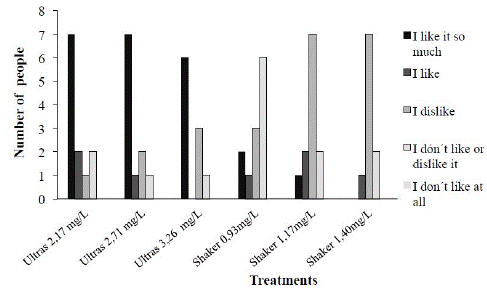
Figure 5 Acceptability grade of dairy products with Calendula officinalis extract (Ultras: ultrasound).
Additionally, color analysis (Table 2) show that extracts with 1.17mg/L, 1.40mg/L (5 and 6 level of shaker treatment), 2.71 mg/L, and 3.26mg/L (5 and 6 level of ultrasound treatment) had similar CIELAB parameters to commercial tangerine and mango yogurts that we analyze (a* 0-7 with slightly red tones, L* between 67 and 85 slightly black and b* between 20 y 35 with yellow colors) so extracts obtained by these techniques are promising for dairy products applications.
3. Antibacterial activity:Table 3 shows the antibacterial activity of ethanolic extracts of Calendula officinalis on E. coli and S. Typhi. These results were interpreted according to proposed by Bansemir et al. (2006), where the zones of inhibition > 15 mm were declared strong, from 8 to 15 mm as moderate, and from 1 to 8 mm as weak activity. The statistical analysis indicates that there are significant differences on the bacteria growth inhibition (p<0.05) according to the extracts obtained by each one of the techniques, mainly on E. coli. According to the analysis of means, the extracts obtained by ultrasound 10 min, 20 min and 30 min had an inhibitory effect of growth on slightly higher E. coli. The greater zone of inhibition was generated by the extract obtained by ultrasound 20 min, with an inhibition halo of 2.7mm (2.7 ± 1.0 mm). However, these value are between 1 to 8mm, which is considered a weak antibacterial activity.
Table 3 Results of antibacterial analysis. * Results expressed in mm of zone of inhibition and as mean ± standard deviation of three independent analyses.

On the other hand, none of the extracts obtained from the different techniques reported a significant zone of inhibition (> 1 mm) on the growth of S. Typhi. Although, treatment with ultrasound 20 min (inhibition zone of 1 mm) has a slightly higher effect on this strain in relation to the other treatments, coinciding with what was observed on the growth inhibition of E. coli. As expected, there was no zone of inhibition in the targets (EtOH and DW), while the positive control (Oxytetracycline 50 mg) showed strong antibacterial activity on both microorganisms.
The results obtained in this investigation coincide with those reported previously for E. coli when they evaluated methanolic extracts of Calendula officinalis flowers (Vora et al., 2018). They indicated that the extracts obtained using a solute-solvent ratio 1:10 for 48 hours, showed no zone of inhibition for the microorganism evaluated. Similarly, Gazala et al. (2016), found that the zone of inhibition for E. coli was between 3.75 mm and 4.5 mm, which according to the proposal by Bansemir et al. (2006), represents a weak antibacterial activity.
In contrast, the zones of inhibition found in the present study are lower than those reported under studies conditions similar to present study (Bissa & Bohra, 2011). Likewise, they differ from the results reported in preliminary study with methanolic and ethanolic extracts observed antibacterial properties on different strains of E. coli, reporting areas of inhibition between 3 mm and 12 mm (Efstratiou et al., 2012).
Differences between results could be attributed at diverse assays and methodologies used in different investigations (Cushnie & Lamb, 2005). Also, inoculum size was considered one of the most important variable in susceptibility in this kind of test (NCCLS, 1999). Additionally, taking into account that the extraction of phytochemicals linked to antibacterial activity is also linked to the solid-liquid relationship, the results could have been influenced by the amount of sample and the volume of the solvent used (Cabello & Belloso, 2009; Goktas, Sahin, & Yigitarslan, 201 5). Moreover, precipitation of biocomposite can affect results and generate bacterial growth and negative results (Cushnie & Lamb, 2005). On the other hand, Waage & Hedin (1985) show that flavonoid glycosides didn't have antimicrobial activity against Pseudomona maltophilia and Enterobacter cloacae by contrast, pure (nonhydroxilate) flavone retarded the growth of yeast so form of metabolite has influenced on this antimicrobial effect.
CONCLUSIONS
Several metabolites extraction techniques were comparing regard the quantity of carotenoids and flavonoids extracted from the Calendula officinalis. The mayor report technique to extract metabolites have been soxhlet, however in this study it reports the worst results in comparison with the other techniques. Newly was conclude that the temperatures necessary to extract metabolites through this technique, produce a denaturalization of said metabolites. On the other hand, no large differences were observed when comparing the extraction by the solute/solvent method without and with agitation (shaker). Both techniques showed an increase of quantity obtained of both metabolites when time was increased. Finally, through ultrasound-assisted extraction technique was obtained the major quantities of metabolites, even in less time than the other techniques. Therefore, it turned out to be the best procedure for the compound extraction from Calendula officinalis flower.
Calendula officinalis extracts can be used as a natural colorant in dairy products specially in a 2.17 and 2.71 mg/L concentration of extract obtained by ultrasound with public acceptability. Dyeing ability of Calendula officinalis extract are similar to those found in dairy commercial products. These results are promising for natural colorant applications in food.
Antibacterial activity results suggest that the bacterial growth inhibition was not influenced according to time of extraction or the concentration of flavonoids obtained. Contrary to expected, no was observed a greater bacteria growth inhibition with a higher concentration of the compound. Therefore, these results are not conclusive. Even though one of the reported intrinsic effects of flavonoids of Calendula officinalis is the antibacterial activity, its effect depends largely on the origin of plants, and the biocompounds concentration. So it is suggested in the future to carry out a study to optimize the extraction conditions with ultrasound technique, in which the concentration of the solute is increased with respect to the solvent. Thus, carotenoids and flavonoids from Calendula officinalis flower can be easily extracted by using ultra sonication, and are also found to be an effective food dye colorant with added antimicrobial properties.















